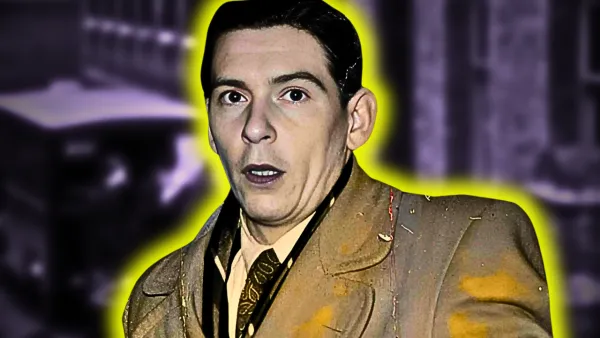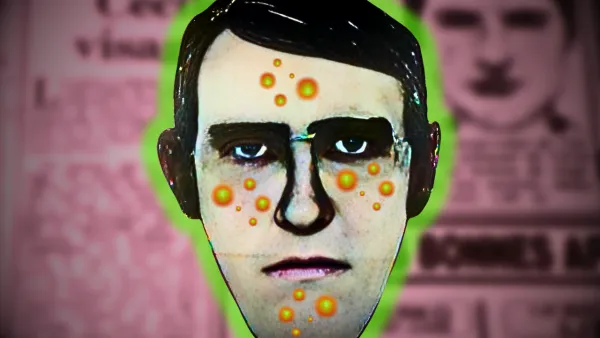The Unbelievable Case of Mary Reeser And Her Spontaneous Combustion

Can a human spontaneously combust into fire and flames? Surely not, right? If the body of Mary Hardy Reeser, a 67-year-old widow, didn't spontaneously combust in the wee hours of Monday, July 2, 1951, then what caused the intense flames that reduced her to ash?
Mary Hardy Reeser, 67, lived alone and died by fire on July 2, 1951.
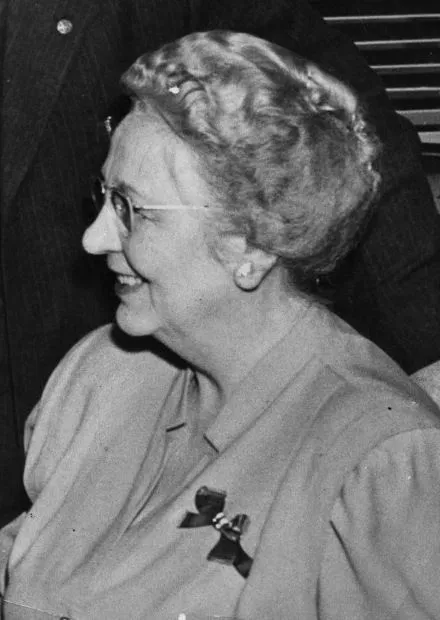
Note* The information in this article regarding the strange death of Mary Reese is comprised almost entirely of a 115 page report from the Federal Bureau of Investigation (F.B.I.); composed, or at least seen by, the infamous director himself, J. Edgar Hoover.
“A Red Smoldering Mass”
The small apartment at 1200 Cherry Street, in St. Petersburg, Florida, was built in 1947 and still stands today. I say "small", because even though sources refer to her home as an "apartment", the 5-unit setup is laid on a single floor. This important when asking questions such as, how were no other apartments alerted by smoke?
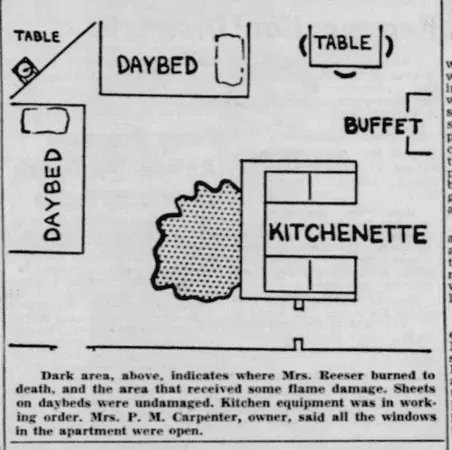
Mary Reeser lived in a studio apartment at 1200 Cherry Street in St. Petersburg, Florida.
The first person to notice something was amiss in Mary's apartment was her neighbor and close friend.
This neighbor (her name not public) claims that she was suddenly awakened around 5 a.m. when she heard a “dull thud”, such as the shutting of a door. This neighbor opened her door, saw nothing and no one, and went back to sleep.
At 8 a.m. a Western Union boy began knocking on this neighbor’s door. The boy had a telegram addressed to Mary Reeser, but could not get Reeser to come to her front door.
Normally Mary would be awake, the soft sound from her morning radio programs passing through the thin apartment walls. With the help of two painters working around the building, the neighbor enters the widow’s apartment. An overwhelming amount of smoke greeted her.
A fire had engulfed a small area of the apartment, but there were no signs of Mary. All that was left of Mary Reeser’s favorite recliner was a “red smoldering mass”.
Slipped On A Greasy Floor
Before S. O. Griffith, St. Petersburg assistant Fire Chief, and his crew entered the apartment they noticed a "very small amount of smoke" coming from the screen door. Griffith would claim that an untrained eye would not have noticed the smoke at all. The doorknob was also hot when touched, evidence that a small fire may still be alive inside.
Soot blackened the apartment ceilings. The soot covered the dining area drapes, which were blackened but not scorched. None of Mary Reese’s furniture had suffered any type of heat damage, other than her reclining “overstuffed” chair, which had been melted down to its metal springs.
Using a small hand pump, the firefighters extinguished small fiery embers still burning under what was once the chair’s seat.
The men then noticed an unusual "greasy substance" which coated the hardwood floor, the walls, and the ceiling. One man had even slipped on the substance, and while down on the floor, noticed something shocking and grotesque. It was a severed leg still wearing its suede shoe.
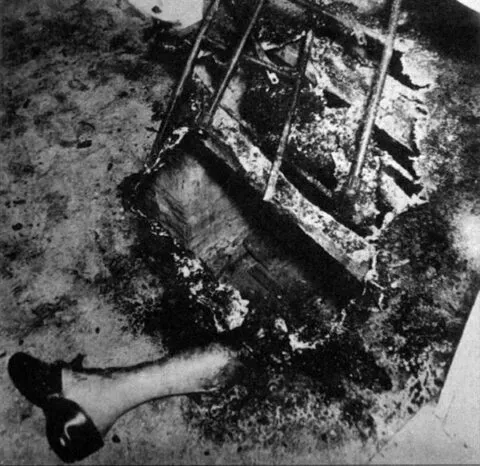
The firefighters noticed a severe foot still inside a suede shoe. Both the shoe and the human calf were unburned.
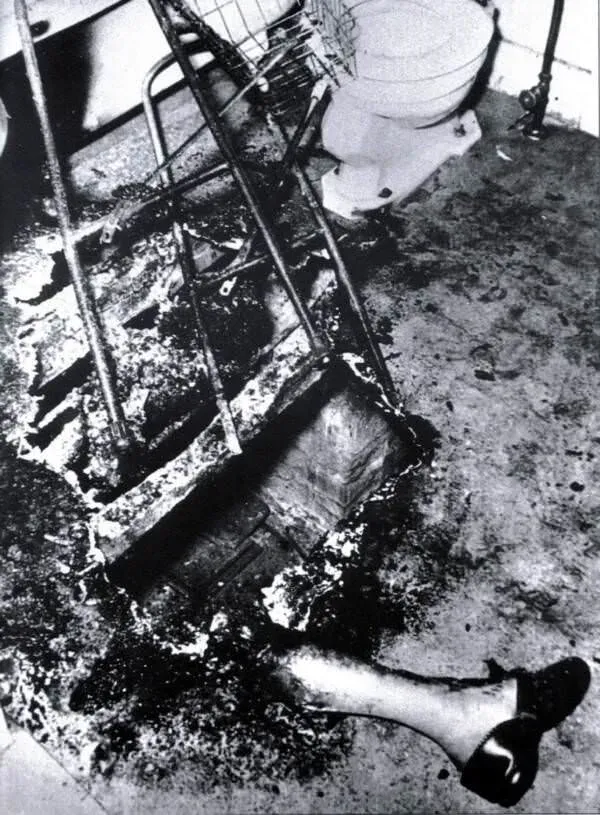
Police found it odd that the fire destroyed only a small portion of Mary’s apartment. Usually, a house fire spreads to the furniture, surrounding walls, or the window drapes. This fire isolated itself to Mary’s recliner, and Mary, of course.
Mary Reeser’s foot rested comfortably inside her suede shoe, which connected her uncharred flesh-toned, apparently burned off by the intense blaze.
According to official reports, “The body of Mrs. Reeser was partially cremated with the exception of the left foot which was burned completely in tow, about 4 inches above the ankle.”
A single suede shoe worn by Mary, which still housed her foot, was unburned. “The chair in which she had been sitting was completely burned away, leaving just the springs. A small end table was completely burned with the exception of 2 legs. The carpet was burned in an area of approximately 3 feet.”
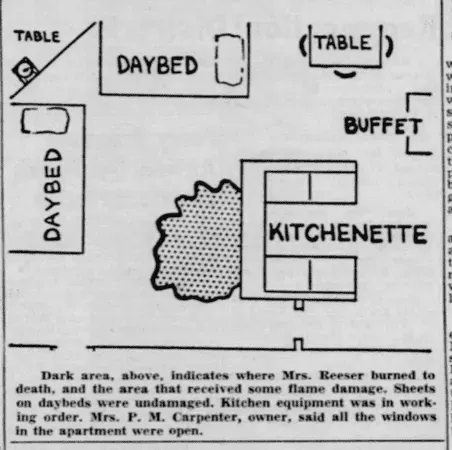
Layout of Mary Reeser's apartment
Also discovered was Mary Reeser’s “charred skull, shrunken to the size of a teacup (or baseball), a section of backbone and a part of a left foot, still encased in a suede shoe.”
All that was left of Mary fit easily in a “small box”.
- Glass fragments found in ashes
- Distorted pieces of glass in Q1 softened when exposed to 1000 - 1100 degrees Fahrenheit (corresponds to bright red heat)
- Six small objects believed to be teeth
- metal from near body
- Portion of cigarette lighter and metal may also be part of lighter
- White metal could be her hearing aid
- Fiber believed to be part of nightgown
- Particles of bones found in ashes
- Charred fabric believed to be from chair
- Cotton material from chair
- Charred wood
- Charred legs from table
- Charred fabric from rug
- Unburned section of rug, heavily soaked with a greasy substance
- Remainder of ashes
- Shoe from foot not consumed by fire
- Chair springs
Police clean up the remaining ashes left of Mary Reeser's body.
As for the greasy substance that caused the firefighter to lose his balance and slip?
F.B.I. forensic testing proved it to be the "melted human fat."
The Night of The Fire
Mary Reeser was once happily married to a local doctor. However, the sudden loss of her husband was devastating. To cope with her grief, Mary depended on her son for comfort. In fact, the official report claimed that Mary’s days “seemed to revolve around her son, Dr. Richard Reeser.”
On the morning before the fire, Dr. Reeser had taken his family to the beach for a well-needed break from both his mother and his increasing workload and patient visits. The family returned home around 3:30 p.m. and found Mary crying in a lounge chair.
Mary usually spent her summer weeks up north, but because of an unforeseen accident with her driver, had to cancel her trip all together. The thought of spending her summer in St. Petersburg saddened her. Mary popped a few Seconals (past-time barbiturates) to calm her mood and tried to look past her sudden state of depression.
At least she could spend her summer with her beloved son.
Dr. Reeser drove her mother back to her own apartment, leaving her around 8 p.m. that evening. When Dr. Reeser left his mother, she was wearing a Van Raalte rayon-acetate night gown, resting in her favorite recliner, and had just lit a cigarette.
Mary Reeser would be burned alive 8 hours later.
The fire damaged was isolated inside Mary's apartment.
Was Mary Reese Murdered?
The police were adamant that Mary Reese had been set on fire, either by herself accidentally or by someone who wanted her dead. Few detectives took the only other viable option seriously, spontaneous human combustion (SHC) also known as Preternatural Combustibility (PC).
Morticians who were interviewed regarding Mary’s death all claimed that inside a crematorium, a body must be exposed to 1,500 t0 2,000 degrees for hours for full cremation. In the crematorium, “bodies are continually sprayed with oil” to keep them burning.
To get a human body to this temperature quickly, an accelerant must be used. However, F.B.I. forensic testing found no type of gasoline or accelerant used on Mary Reeser.
Letters from armchair sleuths sent to the F.B.I. regarding Mary’s death ranged from a natural phenomenon (perhaps a lighting bolt struck her), to full-blown murder. One popular theory being murder, perhaps by her own son, or any person who may have a financial or emotional motive.
The investigation concluded that there were no motives to murder Mary Reeser.
As police ruled out foul play, they searched for other explanations. Could lightning have struck through Mary Reeser’s window, instantly sending her body into a fiery inferno? According to the local meteorology station, there were no thunderstorms. Mary was not struck by lightning.
Police turned back to initial theory that Mary dropped her cigarette on herself. This theory was problematic as “such a blaze could not have produced the intense heat which consumed the body.”
A Possible Conclusion
The popular belief, even today, is that Mary Reeser lit her cigarette and then fell asleep. The ember from the cigarette ignited her nightgown, made of ‘rayon acetate’, a highly inflammable material.
I found a good article that goes in depth about the rayon acetate that composed Mary Reeser’s nightgown the night of the fire.
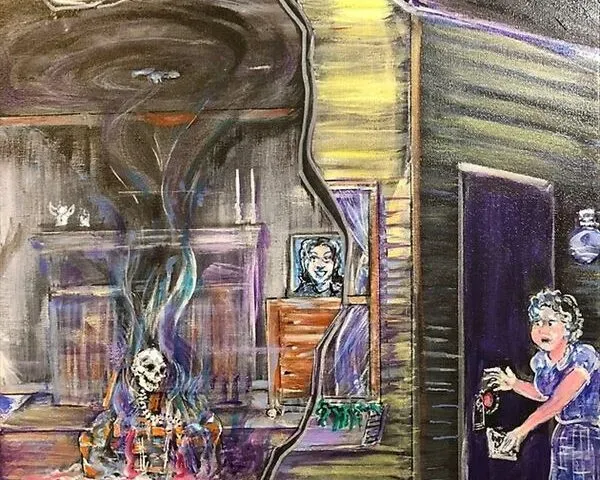
Once Mary Reeser’s nightgown was on fire, her body began heating up, causing a “wicking effect.” And this is super-gross, but the wicking effect is when the fatty tissue under human skin leaks out of the body providing a constant supply of accelerant to keep the fire from dying out.
So, what do you think?
Was the death of Mary Reeser a murder cover-up, spontaneous combustion, or just a horrible freak accident?



